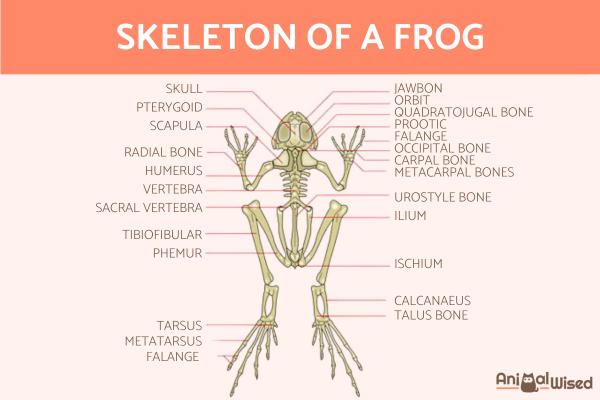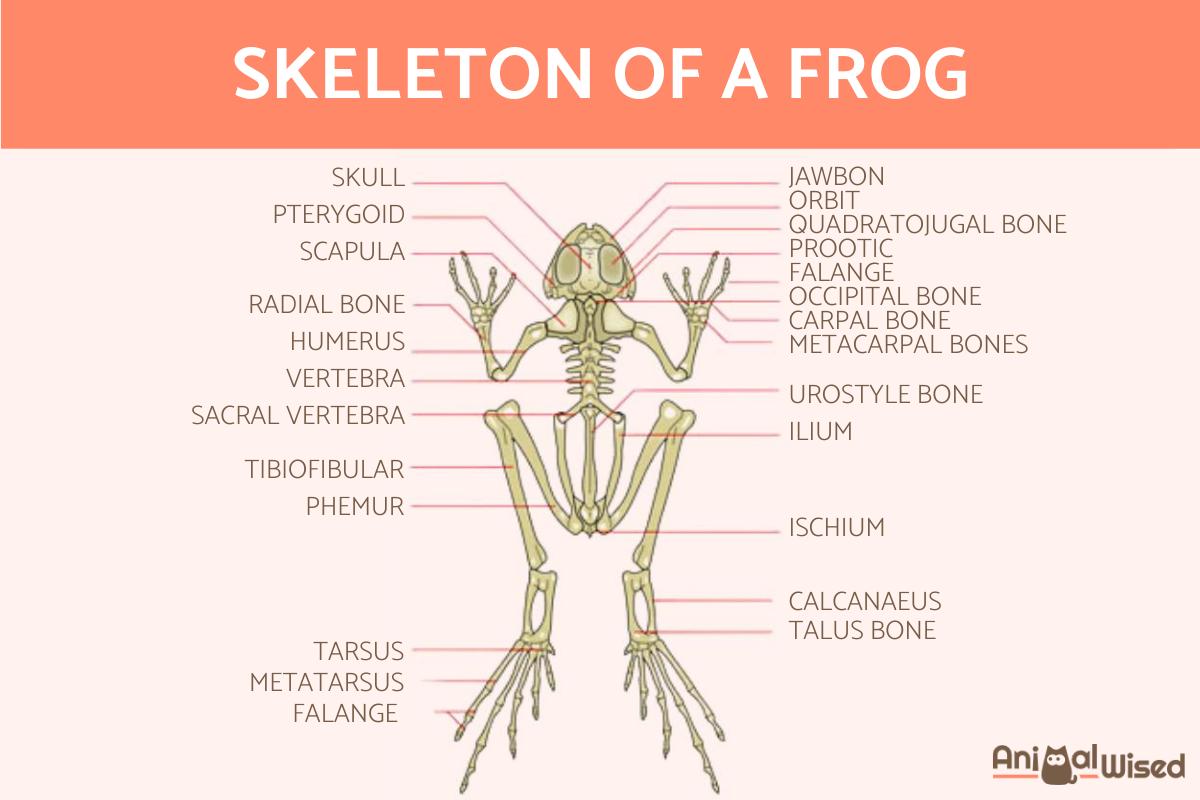Do Frogs Have Bones?


Frogs are vertebrates, which means they have bones. However, the bones of frogs can tell us a lot about their anatomy, physiology, and evolutionary history. Frogs have adapted to a variety of aquatic and terrestrial habitats, and their bones reflect these adaptations. Moreover, development from tadpole to adult frog involves significant changes in bone structure and composition.
The following AnimalWised article answers the question of whether frogs have bones, but also explains the main features of the frog skeleton and bones.
Do frogs have bones?
Frogs are classified as amphibians, a class of vertebrates that also includes salamanders and reptiles. Like other vertebrates, the body of frogs is supported by a skeleton of bones that provides structure and support to the body and protects the internal organs.
Many amphibians, including frogs, toads, and salamanders, are adapted to life in water as well as on land, and are therefore often referred to as "semiaquatic" or "amphibious" animals.
The evolution of frogs from their fish-like ancestors began about 360 million years ago, in the Devonian period. These primitive frogs developed new adaptations that enabled them to live exclusively on land. One of the most important adaptations was the development of moist, permeable skin that allowed them to breathe through their skin, reducing their dependence on water for respiration. But that was not the only change they had to make in order to settle on land.
They also developed strong, muscular legs that allowed them to move quickly and efficiently on land. In addition, their bones became light and porous, allowing them to adapt to a semiaquatic lifestyle.
Frog metamorphosis
Metamorphosis is a series of developmental changes that transform the aquatic, gill-breathing larvae, or tadpoles, into the air-breathing, land-dwelling adults. These adaptations include changes in the skeleton and overall body structure.
In the early stages of their life cycle, amphibians usually live exclusively in water. They lay their eggs in water, and the eggs hatch into aquatic larvae called tadpoles or larvae. These tadpoles breathe through gills and have a fish-like appearance, with a long tail and no legs. As the tadpoles grow and develop, they undergo metamorphosis, a process in which they transform into adult amphibians.
These are some of the adaptations that frog tadpoles develop to live on land:
- Their skin thickens and becomes more durable to protect it from the elements.
- They develop special glands that secrete mucus to keep its skin moist.
- They develop lungs that allow them to breathe air.
- Their tail shrinks and is absorbed.
- Their hind legs begin to grow, eventually becoming fully formed legs.
- Their skeleton, that tends to be cartilaginous in the larval stage, becomes bony.
If you want to learn more about frogs, do not miss this other article where we talk about how frogs reproduce.

What bones do frogs have?
The skeletal system of frogs is modified compared to that of other vertebrates to allow for two types of movement: swimming and jumping.
The bones of the frog's body are divided into different sections. The skull, for example, is made up of several bones that are fused together to form a protective shell around the brain. The spine is made up of many small vertebrae that allow the frog to move its body in a flexible manner.
Frogs also have several specialized bones, such as the urostyle, a long, rod-shaped bone at the base of the spine that supports the hind legs. Another example is the stapes, a tiny bone in the ear that helps transmit sound vibrations to the inner ear.
Frog bones are specialized to support their unique anatomy and lifestyle. Some of the most important features of frog bones are:
- Light and Hollow: frog bones are light and often have air pockets or cavities that make them even lighter. This is because frogs need to move quickly and jump long distances, and their bones need to be light enough to do so.
- Strong and flexible: although they are light, frogs' bones are also strong and flexible, so they can withstand the stresses of jumping and other movements. The bones are reinforced with a network of collagen fibers for added strength and flexibility.
- Fused and modified: some of the bones in a frog's body are fused together to provide more stability and support.
- Reduced or absent in some areas: some areas of the frog's body have reduced or absent bones. For example, frogs do not have ribs on their abdomen, which allows them to expand their bodies when they breathe, and they have reduced bones in their hands and feet to make them more flexible for grasping and jumping.
How many bones does a frog have?
Frogs have a complex skeletal system consisting of many bones. The exact number of bones in a frog's body can vary by species, but on average, an adult frog has about 200 bones.
If you want to learn even more about these fascinating animals, do not miss the following article, where we explain what frogs eat in the wild and in captivity.
What kind of skeleton does a frog have?
The skeletal system of amphibians is well-developed and consists of bones and cartilage that provide support for the muscles that allow movement and, in general, for organs and other systems.
The skeleton of frogs varies in size depending on the species, as some have dimensions of a few millimeters, while others reach almost 40 cm. Likewise, the structure varies according to the way of life, because some are more terrestrial, aquatic or arboreal.
The changes that vertebrates underwent when they came out of the water to live on land led to major changes in the anurans, a group of frogs and toads, to be able to jump on land and swim underwater. Here are some of the major skeletal changes that frogs have undergone:
- The spine of frogs acquired a new function, because it supports the abdomen and the legs. On the other hand, the spine is no longer as flexible as in fish, but much more rigid to transmit the force from the lower extremities to the whole body, which also involved a shortening and fusion of some vertebrae.
- The vertebrae of the spine are often fused together to form a strong, rigid structure.
- The hyoid bone in the frog's mouth is heavily modified to support the tongue used to catch prey.
- The skull is lighter than tht of its ancestors, the profile is deeper and there are fewer cavities. In addition, the anterior region of the skull, where the brain, eyes, and nose are located, is very well-developed, while the posterior region is rather reduced.
- The tibia and fibula are fused together, as are the radius and ulna, which helps them when jumping. In addition, the last vertebrae are also fused together, forming the urostyle bone, which is located in the pelvis and gives strength to the hind limbs when jumping.
- Their leg bones are designed for jumping and fast movements. The limbs are made up of long bones such as the femur (thigh bone) and tibia (shin bone) that support the weight of the body and allow it to jump and make other movements.
Overall, the frogs' complex skeletal system is adapted to their unique way of life. It allows them to move and jump with great agility, catch prey with their specialized tongues, and protect their internal organs from injury.
If you want to learn even more about the unique physique of frogs, do not miss this other article, where we talk about whether frogs have teeth or not.

If you want to read similar articles to Do Frogs Have Bones?, we recommend you visit our Facts about the animal kingdom category.
- Hickman, C.; Roberts, L.; Parson A. (2000). Comprehensive principles of zoology . McGraw Hill Inter-American: Spain.







